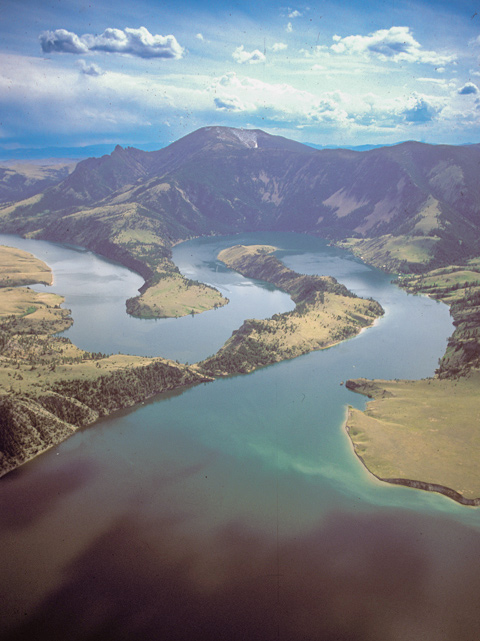Once past the Great Falls of the Missouri, on 18 July 1805, the captains agreed that Lewis would take the flotilla on upstream while Clark, with York and Pvts. Joseph Field and John Potts, walked parallel to the river on the right side in the hope of meeting some Shoshones. Continuing along a wide and sometimes very crooked road that in some places appeared to have been dug out of the steep mountainsides, Clark’s party saw plenty of evidence that Indians had passed through recently, but they saw not a soul.
Lewis and the rest of the party “proceeded on tolerably well.” As the current became stronger, they rowed, towed, and pushed with setting poles Though there was snow on some of the surrounding peaks, they “were almost suffocated in this confined vally with heat.”
Two historic landmarks stand out in this view. The one now called Oxbow Bend, which Lewis “doubled” on the nineteenth, is now nearly submerged under the 26.5-mile-long Holter Lake, the impoundment of the Holter Dam, built in 1916. The river as he saw it was about thirty feet lower, and maybe one-fourth as wide.
If anyone noticed the other landmark, the one known for perhaps 12,000 years as the Bears Tooth when viewed from the north, or Sleeping Giant when viewed from the south (the “face” is at upper left on the ridge, with the “torso” at center), none of the journalists mentioned it, although both captains knew of it. It was a kind of milepost on the ancient Indian superhighway now referred to as the Old North Trail.[1]Walter McClintock, The Old North Trail, or, Life, Legends, and Religion of the Blackfeet Indians (1910; reprint, Lincoln: University of Nebraska Press, 1992). Lewis was in command of the canoes; Clark was in the valley to the west of the mountain, anxiously looking for signs of Shoshone Indians.
From Discovering Lewis & Clark from the Air
Photography by Jim Wark
Text by Joseph Mussulman
Reproduced by permission of Mountain Press
Notes
| ↑1 | Walter McClintock, The Old North Trail, or, Life, Legends, and Religion of the Blackfeet Indians (1910; reprint, Lincoln: University of Nebraska Press, 1992). |
|---|

